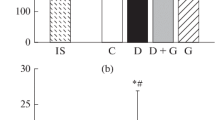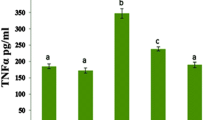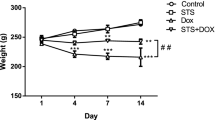Abstract
The clinical use of antineoplastic agent doxorubicin (DOX) is limited due to its cardiotoxic action. [βAla14, His15]-galanine (2–15) (G) is a novel synthetic agonist of galanin receptors GalR1-3 having cardioprotective properties in animal models in vivo. The aim of the present study was to explore effects of G on DOX-induced cardiotoxicity. Wistar rats were divided into four groups and treated with DOX (D group), DOX and G (D + G group), G (G group), and saline (control). Before treatment and at the end of the study, concentration of thiobarbituric acid reactive substances (TBARS) and activity of creatine kinase-MB (CK-MB) were determined in blood plasma, the animals were weighed, and cardiac function was evaluated by echocardiography. At the end of experiments, the hearts were used to determine energy metabolites and mitochondrial respiration in permeabilized fibers. After an 8-week study, D group exhibited a pronounced cardiac failure, the absence of weight gain, an increased plasma TBARS concentration, and CK-MB activity. These disorders were accompanied by a reduced myocardial content of high-energy phosphates and mitochondrial respiratory parameters. Co-administration of G with DOX significantly decreased plasma TBARS level and prevented an increase in plasma CK-MB activity. In D + G group, myocardial contents of ATP, PCr, total adenine nucleotides, and total creatine as well as myocardial PCr/ATP ratio and the respiratory control index were higher than in D group at the end of the experiments. Peptide G significantly improved parameters of left ventricular (LV) function and caused weight gain in animals of D + G group. These results suggest that peptide G may be a potential pharmacological agent that attenuates the cardiotoxic effects of DOX.



Similar content being viewed by others
References
Todaro, M. C., Oreto, L., Qamar, R., Paterick, T. E., Carerj, S., & Khandheria, B. K. (2013). Cardioncology: State of the heart. International Journal of Cardiology, 168(2), 680–687. https://doi.org/10.1016/j.ijcard.2013.03.133.
Wojtacki, J., Lewicka-Nowak, E., & Lesniewski-Kmak, K. (2000). Anthracycline-induced cardiotoxicity: Clinical course, risk factors, pathogenesis, detection and prevention—review of the literature. Medical Science Monitor, 6(2), 411–420.
Swain, S. M., Whaley, F. S., & Ewer, M. S. (2003). Congestive heart failure in patients treated with doxorubicin: A retrospective analysis of three trials. Cancer, 97(11), 2869–2879. https://doi.org/10.1002/cncr.11407.
Hayward, R., & Hydock, D. S. (2007). Doxorubicin cardiotoxicity in the rat: An in vivo characterization. Journal of the American Association for Laboratory Animal Science, 46(4), 20–32.
Legha, S. S., Benjamin, R. S., Mackay, B., Ewer, M., Wallace, S., Valdivieso, M., et al. (1982). Reduction of doxorubicin cardiotoxicity by prolonged continuous intravenous infusion. Annals of Internal Medicine, 96(2), 133–139.
Cusack, B. J., Gambliel, H., Musser, B., Hadjokas, N., Shadle, S. E., Charlier, H., & Olson, R. D. (2006). Prevention of chronic anthracycline cardiotoxicity in the adult Fischer 344 rat by dexrazoxane and effects on iron metabolism. Cancer Chemotherapy and Pharmacology, 58(4), 517–526. https://doi.org/10.1007/s00280-006-0199-4.
Li, T., Danelisen, I., Bello-Klein, A., & Singal, P. K. (2000). Effects of probucol on changes of antioxidant enzymes in adriamycin-induced cardiomyopathy in rats. Cardiovascular Research, 46(3), 523–530.
Swenson, C. E., Bolcsak, L. E., Batist, G., Guthrie, T. H. Jr., Tkaczuk, K. H., Boxenbaum, H., et al. (2003). Pharmacokinetics of doxorubicin administered i.v. as Myocet (TLC D-99; liposome-encapsulated doxorubicin citrate) compared with conventional doxorubicin when given in combination with cyclophosphamide in patients with metastatic breast cancer. Anti-Cancer Drugs, 14(3), 239–246. https://doi.org/10.1097/01.cad.0000060626.61556.da.
Renu, K., & Arunachalam, S. (2018). Molecular mechanism of doxorubicin-induced cardiomyopathy—An update. European Journal of Pharmacology, 818(5), 241–253. https://doi.org/10.1016/j.ejphar.2017.10.043.
Faber, M., Coudray, C., Hida, H., Mousseau, M., & Favier, A. (1995). Lipid peroxidation products, and vitamin and trace element status in patients with cancer before and after chemotherapy, including adriamycin. A preliminary study. Biological Trace Element Research, 47(1–3), 117–123. https://doi.org/10.1007/BF02790108.
Zhang, S., Liu, X., Bawa-Khalfe, T., Lu, L. S., Lyu, Y. L., Liu, L. F., & Yeh, E. T. (2012). Identification of the molecular basis of doxorubicin-induced cardiotoxicity. Nature Medicine, 18(11), 1639–1642. https://doi.org/10.1038/nm.2919.
Vejpongsa, P., & Yeh, E. T. (2014). Topoisomerase 2β: A promising molecular target for primary prevention of anthracycline-induced cardiotoxicity. Clinical Pharmacology & Therapeutics, 95(1), 45–52. https://doi.org/10.1038/clpt.2013.201.
Deng, S., Yan, T., Jendrny, C., Nemecek, A., Vincetic, M., Gödtel-Armbrust, U., & Wojnowski, L. (2014). Dexrazoxane may prevent doxorubicin-induced DNA damage via depleting both Topoisomerase II isoforms. BMC Cancer, 14, 842. https://doi.org/10.1186/1471-2407-14-842.
Octavia, Y., Tocchetti, C. G., Gabrielson, K. L., Janssens, S., Crijns, H. J., & Moens, A. L. (2012). Doxorubicin-induced cardiomyopathy: From molecular mechanisms to therapeutic strategies. Journal of Molecular and Cellular Cardiology, 52(6), 1213–1225. https://doi.org/10.1016/j.yjmcc.2012.03.006.
Tokarska-Schlattner, M., Zaugg, M., da Silva, R., Lucchinetti, E., Schaub, M. C., Wallimann, T., & Schlattner, U. (2005). Acute toxicity of doxorubicin on isolated perfused heart: Response of kinases regulating energy supply. American Journal of Physiology Heart and Circulatory Physiology, 289(1), H37–H47. https://doi.org/10.1152/ajpheart.01057.2004.
Nicolay, K., Aue, W. P., Seelig, J., van Echteld, C. J., Ruigrok, T. J., & de Kruijff, B. (1987). Effects of the anti-cancer drug adriamycin on the energy metabolism of rat heart as measured by in vivo 31P-NMR and implications for adriamycin-induced cardiotoxicity. Biochimica et Biophysica Acta, 929(1), 5–13.
Chatham, J. C., Cousins, J. P., & Glickson, J. D. (1990). The relationship between cardiac function and metabolism in acute adriamycin-treated perfused rat hearts studied by 31P and 13C NMR spectroscopy. Journal of Molecular and Cellular Cardiology, 22(10), 1187–1197.
Ueno, M., Kakinuma, Y., Yuhki, K., Murakoshi, N., Iemitsu, M., Miyauchi, T., & Yamaguchi, I. (2006). Doxorubicin induces apoptosis by activation of caspase-3 in cultured cardiomyocytes in vitro and rat cardiac ventricles in vivo. Journal of Pharmacological Sciences, 101(2), 151–158. https://doi.org/10.1254/jphs.FP0050980.
Cassidy, S. C., Chan, D. P., Rowland, D. G., & Allen, H. D. (1998). Effects of doxorubicin on diastolic function, contractile reserve, and ventricular–vascular coupling in piglets. Pediatric Cardiology, 19(6), 450–457. https://doi.org/10.1007/s002469900355.
Mitsukawa, K., Lu, X., & Bartfai, T. (2008). Galanin, galanin receptors and drug targets. Cellular and Molecular Life Sciences, 65(12), 1796–1805. https://doi.org/10.1007/s00018-008-8153-8.
Timotin, A., Pisarenko, O., Sidorova, M., Studneva, I., Shulzhenko, V., Palkeeva, M., et al. (2017). Myocardial protection from ischemia/reperfusion injury by exogenous galanin fragment. Oncotarget, 8(13), 21241–21252. https://doi.org/10.18632/oncotarget.15071.
Serebryakova, L., Pal’keeva, M., Studneva, I., Molokoedov, A., Veselova, O., Ovchinnikov, M., et al. (2018). Galanin and its N-terminal fragments reduce acute myocardial infarction in rats. Peptides. https://doi.org/10.1016/j.peptides.2018.05.001.
Pisarenko, O., Timotin, A., Sidorova, M., Studneva, I., Shulzhenko, V., Palkeeva, M., et al. (2017). Cardioprotective properties of N-terminal galanin fragment (2–15) in experimental ischemia/reperfusion injury. Oncotarget, 8(60), 101659–101671. https://doi.org/10.18632/oncotarget.21503.
Webling, K. E. B., Runesson, J., Bartfai, T., & Langel, Ü (2012). Galanin receptors and ligands. Frontiers in Endocrinology, 3, 146. https://doi.org/10.3389/fendo.2012.00146.
Kang, Y., Wang, W., Zhao, H., Qiao, Z., Shen, X., & He, B. (2017). Assessment of subclinical doxorubicin-induced cardiotoxicity in a rat model by speckle-tracking imaging. Arqiuvos Brasilieros de Cardiologia, 109(2), 132–139. https://doi.org/10.5935/abc.20170097.
Nair, A. B., & Jacob, S. (2016). A simple practice guide for dose conversion between animals and human. Journal of Basic and Clinical Pharmacy, 7(2), 27–31. https://doi.org/10.4103/0976-0105.177703.
Turner, P. V., Brabb, T., Pekow, C., & Vasbinder, M. A. (2011). Administration of substances to laboratory animals: Routes of administration and factors to consider. Journal of the American Association for Laboratory Animal Science, 50(5), 600–613.
Bergmeyer, H. U. (1974). Methods of enzymatic analysis (pp. 1464–1467 1772–1776, 1777–17781, 2127–2131). New York: Academic Press.
Kuznetsov, A. V., Veksler, V., Gellerich, F. N., Saks, V., Margreiter, R., & Kunz, W. S. (2008). Analysis of mitochondrial function in situ in permeabilized muscle fibers, tissues and cells. Nature Protocols, 3(6), 965–976. https://doi.org/10.1038/nprot.2008.61.
Curtis, M. J., Bond, R. A., Spina, D., Ahluwalia, A., Alexander, S. P., Giembycz, M. A., et al. (2015). Experimental design and analysis and their reporting: new guidance for publication in BJP. British Journal of Pharmacology, 172(14), 3461–3471. https://doi.org/10.1111/bph.12856.
Tabaczar, S., Koceva-Chyla, A., Czepas, J., Pieniazek, A., Piasecka-Zelga, J., & Gwozdzinski, K. (2012). Nitroxide pirolin reduces oxidative stress generated by doxorubicin and docetaxel in blood plasma of rats bearing mammary tumor. Journal of physiology and pharmacology, 63(2), 153–163.
Alimoradi, H., Barzegar-Fallah, A., Hassanzadeh, G., Mohammadi-Rick, S., Asadi, F., Delfan, B., et al. (2012). The cardioprotective effects of an antiemetic drug, tropisetron, on cardiomyopathy related to doxorubicin. Cardiovascular Toxicology, 12(4), 318–325. https://doi.org/10.1007/s12012-012-9175-x.
Williams, J. P., & Headrick, J. P. (1996). Differences in nucleotide compartmentation and energy state in isolated and in situ rat heart: Assessment by 31P-NMR spectroscopy. Biochimica et Biophysica Acta, 1276(1), 71–79.
Zervou, S., Whittington, H. J., Russell, A. J., & Lygate, C. A. (2016). Augmentation of creatine in the heart. Mini-Reviews in Medicinal Chemistry, 16(1), 19–28. https://doi.org/10.2174/1389557515666150722102151.
Kakuyama, H., Kuwahara, A., Mochizuki, T., Hoshino, M., & Yanaihara, N. (1997). Role of N-terminal active sites of galanin in neurally evoked circular muscle contractions in the guinea-pig ileum. European Journal of Pharmacology, 329(1), 85–91. https://doi.org/10.1016/S0014-2999(97)10109-1.
Díaz-Cabiale, Z., Parrado, C., Vela, C., Razani, H., Coveñas, R., Fuxe, K., & Narváez, J. A. (2005). Role of galanin and galanin(1–15) on central cardiovascular control. Neuropeptides, 39(3), 185–190. https://doi.org/10.1016/j.npep.2004.12.009.
Liu, H. X., Brumovsky, P., Schmidt, R., Brown, W., Payza, K., Hodzic, L., et al. (2001). Receptor subtype-specific pronociceptive and analgesic actions of galanin in the spinal cord: Selective actions via GalR1 and GalR2 receptors. Proceedings of the National Academy of Sciences of the USA, 98(17), 9960–9964. https://doi.org/10.1073/pnas.161293598.
Lundstrom, L., Sollenberg, U. E., Bartfai, T., & Langel, U. (2007). Molecular characterization of the ligand binding site of the human galanin receptor type 2, identifying subtype selective interactions. Journal of Neurochemistry, 103(5), 1774–1784. https://doi.org/10.1111/j.1471-4159.2007.04959.x.
Kim, A., & Park, T. (2010). Diet-induced obesity regulates the galanin-mediated signaling cascade in the adipose tissue of mice. Molecular Nutrition & Food Research, 54(9), 1361–1370. https://doi.org/10.1002/mnfr.200900317.
Lang, R., Gundlach, A. L., & Kofler, B. (2007). The galanin peptide family: receptor pharmacology, pleiotropic biological actions, and implications in health and disease. Pharmacology & Therapeutics, 115(2), 177–207. https://doi.org/10.1016/j.pharmthera.2007.05.009.
Torres, V. M., & Simic, V. D. (2012). Doxorubicin-induced oxidative injury of cardiomyocytes—do we have right strategies for prevention? In M. Fiuzapp (Ed.), Cardiotoxicity of oncologic treatments (pp. 89–130). Rijeka: InTech Europe.
Lebrecht, D., Geist, A., Ketelsen, U.-P., Haberstroh, J., Setzer, B., & Walker, U. A. (2007). Dexrazoxane prevents doxorubicin-induced long-term cardiotoxicity and protects myocardial mitochondria from genetic and functional lesions in rats. British Journal of Pharmacology, 151(6), 771–778. https://doi.org/10.1038/sj.bjp.0707294.
QuanJun, Y., GenJin, Y., LiLi, W., YongLong, H., Yan, H., Jie, L., JinLu, H., Jin, L., Run, G., & Cheng, G. (2017). Protective effects of dexrazoxane against doxorubicin-induced cardiotoxicity: A Metabolomic study. PLoS ONE, 12(1), e0169567. https://doi.org/10.1371/journal.pone.0169567.
Héon, S., Bernier, M., Servant, N., Dostanic, S., Wang, C., Kirby, G. M., et al. (2003). Dexrazoxane does not protect against doxorubicin-induced damage in young rats. American Journal of Physiology Heart and Circulatory Physiology, 285(2), H499–H506. https://doi.org/10.1152/ajpheart.00047.2003.
Acknowledgements
The authors are grateful to Dr. A. Prosvirnin for carrying out echocardiography studies and processing the results. This study was supported by the Russian Foundation for Basic Research (Grant No. 18-015-00008).
Author information
Authors and Affiliations
Corresponding author
Ethics declarations
Conflict of interest
The authors declare that they have no conflict of interest.
Ethical Approval
All applicable international and national guidelines for the care and use of animals were followed. The experiments with animals were approved by the Bioethical Committee for Animal Care of National Medical Research Center for Cardiology (Permission No. 12 of 19 September 2017).
Informed Consent
Informed consent was obtained from all individual participants included in the study.
Additional information
Handling Editor: Martin Štěrba.
Rights and permissions
About this article
Cite this article
Studneva, I., Palkeeva, M., Veselova, O. et al. Protective Effects of a Novel Agonist of Galanin Receptors Against Doxorubicin-Induced Cardiotoxicity in Rats. Cardiovasc Toxicol 19, 136–146 (2019). https://doi.org/10.1007/s12012-018-9483-x
Published:
Issue Date:
DOI: https://doi.org/10.1007/s12012-018-9483-x




